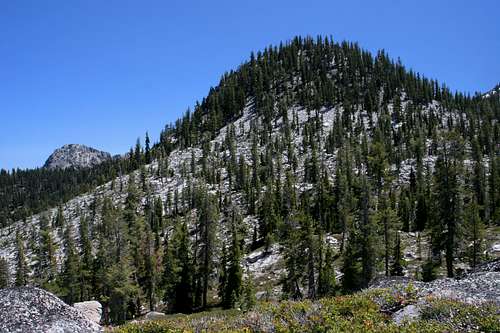-
 7542 Hits
7542 Hits
-
 85.36% Score
85.36% Score
-
 20 Votes
20 Votes
|
|
Mountain/Rock |
|---|---|
|
|
41.03945°N / 122.81466°W |
|
|
Trinity |
|
|
Hiking, Scrambling |
|
|
Spring, Summer, Fall |
|
|
7435 ft / 2266 m |
|
|
Overview
For an unknown reason, the majority of peaks in the Trinity Alps never received official names. There are dozens upon dozens of major peaks, many exceeding 8,000 feet, which have gone without appellations. Some of the more prominent peaks have received unofficial names, names that lack official recognition but are nonetheless generally accepted by those who take an interest in such matters. The most prominent example of this is Caesar Peak, the second highest summit in the Trinity Alps. Other prominent examples of this are Trinity Journal Mountain, a granite behemoth at the southern end of Canyon Creek, Mount Temple, the giant crag towering above Siligo Meadow and Tapie Peak, one of the more accessible summits in the Trinity Alps. The peak and the lake below it take their name from the Tapie family, which pioneered the area in the 19th Century.
Tapie Peak is a large granite turret located high above the Boulder Lake basin. Why the peak never received official recognition of its name is a mystery. In spite of its official anonymity, Tapie Peak remains one of the easiest peaks in the Trinity Alps to summit. In so doing, one passes not 1 or 2 lakes but 5. If one throws in attractive meadows, great views both from the summit and en route, as well as some interesting route finding problems, climbing Tapie Peak is a particularly attractive endeavor. Despite this, the summit sees very few visitors. This is especially odd since Boulder Lake, which is found at the foot of the mountain, is one of the most popular destinations in the Trinity Alps.
The reasons for Boulder Lake’s popularity are easy to discern. It is a large, deep glacial lake, surrounded by lush meadows and soaring granite cliffs. Add to this a short, nearly level trail leading to the lake and the opportunity to stop at another attractive lake a short distance off the trail and one has all the ingredients for a popular alpine destination. Of the many who make the trek to Boulder Lake, a tiny fraction takes the trouble to climb to the top of Tapie Peak. Those who do not make the trip up Tapie Peak miss the spectacular views from the summit as well as the opportunity to visit three more small alpine lakes; Tapie, Lost and Found Lakes. Of the three, Found and Tapie Lakes are the more attractive. Found Lake in particular offers some beautiful campsites with the granite dome of Tapie Peak looming a short distance away.
Tapie Peak has a dome-like appearance when viewed from Boulder Lake. Sparse tree cover exposes rugged granite. From the east, the mountain has a particularly rugged façade, displaying craggy granite and numerous and large talus slopes. The west side of the mountain has horrific brushfields that makes passage through the area undesirable. The northern side of the peak has a talus field nearly all the way to the top. This side provides the easiest route to the summit of the mountain.
Tapie Peak sits astride the divide separating Boulder Creek and the North Fork of Swift Creek. Though commonly lumped into the region of the Trinity Alps called the Red Trinities (which is due to the red peridotite that dominates the area), Tapie Peak is found in an area that consists primarily of granite. Other granite summits in the area include Ycatapom Peak and Thumb Rock to the south and Sugar Pine Butte to the north. Glacial activity in the area is displayed by the deep canyons, glacially polished granite and numerous lakes found in glacial cirques.
Routes
Tapie Peak can be approached from a variety of directions. The most direct route is from Boulder Lake. More information on this route can be found here. Other options to reaching the peak include coming from Boulder Creek or climbing the divide between Boulder Lake and Poison Canyon, near Ycatapom Peak.Getting There
In downtown Weaverville, drive north on Highway 3 for 40 miles. About 0.25 miles south of Coffee Creek, turn left onto Forest Road 37N52. The turnoff is signed for Boulder Lake. Stay on the road for 11 miles, following the signs to the trailhead.Red Tape
Tapie Peak is located in the Trinity Alps Wilderness. Normal wilderness rules and ethics apply. Wilderness permits must be obtained to camp in the wilderness area. A fire permit is necessary to have campfires.
Shasta-Trinity National Forest
3644 Avtech Parkway
Redding, CA 96002
(530)226-2500
Weaverville Ranger Station
P.O. Box 1190
360 Main Street
Weaverville, CA 96093
(530)623-2121
Camping
The nearest campground is the Goldfield Campground operated by the US Forest Service, which is located near the confluence of Boulder Creek and Coffee Creek. There are a couple of privately operated campgrounds in Coffee Creek as well. A little north of Coffee Creek on Highway 3 is the Trinity River Campground, which is an excellent choice, especially if one wants to fish. Numerous campgrounds can be found a little further south of Coffee Creek, around Trinity Lake.
There are numerous excellent campsites around Boulder Lake, especially at the north end near the outlet. Lush meadows can be found on the east side of the lake. Boulder Lake can get particularly busy during the summer. If this is the case, two good campsites are available at Little Boulder Lake. However, if lakes and climbing Tapie Peak are the goal, then the best option is to climb up to Found Lake and camp there. While the lake may be smaller than Boulder and lack the meadows, the views are spectacular, the isolation practically guaranteed and the peak are is just a short distance away.






